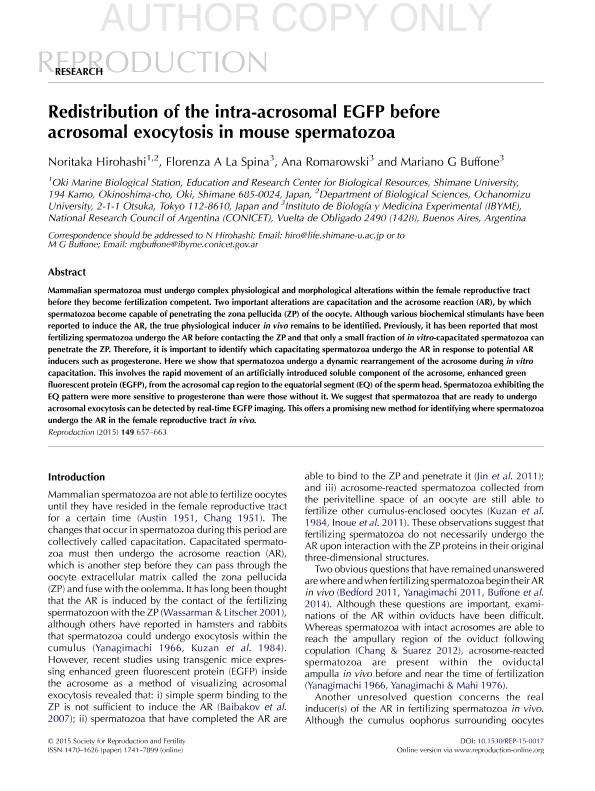Mostrar el registro sencillo del ítem
dc.contributor.author
Hirohashi, Noritaki
dc.contributor.author
la Spina, Florenza Antonella

dc.contributor.author
Romarowski, Ana

dc.contributor.author
Buffone, Mariano Gabriel

dc.date.available
2016-12-26T19:59:21Z
dc.date.issued
2015-05
dc.identifier.citation
Hirohashi, Noritaki; la Spina, Florenza Antonella; Romarowski, Ana; Buffone, Mariano Gabriel; Redistribution of the intra-acrosomal EGFP before acrosomal exocytosis in mouse spermatozoa; Bioscientifica; Reproduction; 149; 6; 5-2015; 657-663
dc.identifier.issn
1470-1626
dc.identifier.uri
http://hdl.handle.net/11336/10210
dc.description.abstract
Mammalian spermatozoa must undergo complex physiological and morphological alterations within the female reproductive tract before they become fertilization competent. Two important alterations are capacitation and the acrosome reaction (AR), by which spermatozoa become capable of penetrating the zona pellucida (ZP) of the oocyte. Although various biochemical stimulants have been reported to induce the AR, the true physiological inducer in vivo remains to be identified. Previously, it has been reported that most fertilizing spermatozoa undergo the AR before contacting the ZP and that only a small fraction of in vitro-capacitated spermatozoa can penetrate the ZP. Therefore, it is important to identify which capacitating spermatozoa undergo the AR in response to potential AR inducers such as progesterone. Here we show that spermatozoa undergo a dynamic rearrangement of the acrosome during in vitro capacitation. This involves the rapid movement of an artificially introduced soluble component of the acrosome, enhanced green fluorescent protein (EGFP), from the acrosomal cap region to the equatorial segment (EQ) of the sperm head. Spermatozoa exhibiting the EQ pattern were more sensitive to progesterone than were those without it. We suggest that spermatozoa that are ready to undergo acrosomal exocytosis can be detected by real-time EGFP imaging. This offers a promising new method for identifying where spermatozoa undergo the AR in the female reproductive tract in vivo.
dc.format
application/pdf
dc.language.iso
eng
dc.publisher
Bioscientifica

dc.rights
info:eu-repo/semantics/openAccess
dc.rights.uri
https://creativecommons.org/licenses/by-nc-sa/2.5/ar/
dc.subject
Espermatozoa
dc.subject
Acrosome
dc.subject
Egfp
dc.subject
Fertilization
dc.subject.classification
Biología Reproductiva

dc.subject.classification
Ciencias Biológicas

dc.subject.classification
CIENCIAS NATURALES Y EXACTAS

dc.title
Redistribution of the intra-acrosomal EGFP before acrosomal exocytosis in mouse spermatozoa
dc.type
info:eu-repo/semantics/article
dc.type
info:ar-repo/semantics/artículo
dc.type
info:eu-repo/semantics/publishedVersion
dc.date.updated
2016-10-04T19:25:35Z
dc.identifier.eissn
1741-7899
dc.journal.volume
149
dc.journal.number
6
dc.journal.pagination
657-663
dc.journal.pais
Reino Unido

dc.journal.ciudad
Cambridge
dc.description.fil
Fil: Hirohashi, Noritaki. Shimane University; Japón. Ochanomizu University; Japón
dc.description.fil
Fil: la Spina, Florenza Antonella. Consejo Nacional de Investigaciones Científicas y Técnicas. Instituto de Biología y Medicina Experimental (i); Argentina
dc.description.fil
Fil: Romarowski, Ana. Consejo Nacional de Investigaciones Científicas y Técnicas. Instituto de Biología y Medicina Experimental (i); Argentina
dc.description.fil
Fil: Buffone, Mariano Gabriel. Consejo Nacional de Investigaciones Científicas y Técnicas. Instituto de Biología y Medicina Experimental (i); Argentina
dc.journal.title
Reproduction

dc.relation.alternativeid
info:eu-repo/semantics/altIdentifier/url/http://www.reproduction-online.org/content/149/6/657
dc.relation.alternativeid
info:eu-repo/semantics/altIdentifier/doi/http://dx.doi.org/10.1530/REP-15-0017
dc.relation.alternativeid
info:eu-repo/semantics/altIdentifier/url/https://www.ncbi.nlm.nih.gov/pmc/articles/PMC4458856/
Archivos asociados
